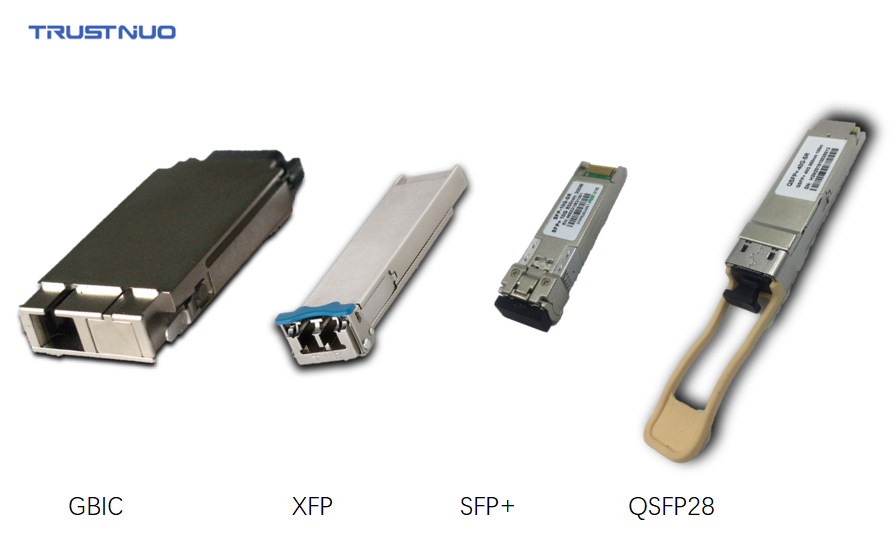What‘s the package type about Optical Transceiver?

Let’s talk about it now……#GBIC #SFP #SFP+ #XFP #QSFP #QSFP+ #QSFP28 #QSFP56
GBIC (gigabit interface converter)
In the earlier of 1990s, the GBIC is typically employed in fiber optic and Ethernet systems as an interface for high-speed networking. GBIC (gigabit interface converter) that converts electric currents (digital highs and lows) to optical signals, and optical signals to digital electric currents.
The typical GBIC transceiver is a plug-in module that is hot-swappable (it can be removed and replaced without turning off the system). GBIC modules allow technicians to easily configure and upgrade electro-optical communications networks.
The data transfer rate is one gigabit per second (1 Gbps) or more. It only supports the data rate of 52M/155M/622M/1.25G.
SFP (small form-factor pluggable) & SFP+
However, a big size of GBIC module was not feasible to provide more numbers of interfaces on a line card or a switch since it occupies more space. In order to resolve this issue people came up with SFPs which were smaller in size hence you can have more interfaces on the same line card or switch compared to GBICs. SFP module is much smaller than GBIC module. For this reason, SFP is considered as an upgraded version of GBIC module.
SFP/SFP+ is the latest pluggable 10Gbit/s Optical Transceiver. Its form factor is compatible with SFP, which is a major lower-speed optical Transceiver on conventional optical networks. Sumitomo Electric had developed the 300pin, X2 and XFP as 10Gbit/s Optical Transceiver.
XFP (10 Gigabit Small Form Factor Pluggable)
XFP modules are hot swappable and support multiple physical layer variants. They typically operate at near-infrared wavelengths (colors) of 850 nm, 1310 nm or 1550 nm. XFP modules use an LC fiber connector type to achieve higher density.
The XFP specification was developed by the XFP Multi Source Agreement Group. It is an informal agreement of an industry group, not officially endorsed by any standards body. The first preliminary specification was published on March 27, 2002. The first public release was on July 19, 2002. It was adopted on March 3, 2003, and updated with minor updates through August 31, 2005
QSFP/QSFP+ (Quad Small Form-factor Pluggable)
- 4 Gbit/s QSFP (4x1Gbps)
- 40 Gbit/s QSFP+ (4*10Gbps)
- 100 Gbit/s QSFP28
- 200 Gbit/s QSFP56
QSFP, or quad small form factor pluggable, is another type of compact, hot-swappable transceiver. It supports Ethernet, Fiber Channel, InfiniBand and SONET/SDH standards with different data rate options. QSFP modules are commonly available in several different types: 4x1Gbps QSFP, 4x10Gbps QSFP+, 4x28Gbps QSFP28.
QSFP+ is an evolution of QSFP to support four 10 Gbit/s channels carrying 10 Gigabit Ethernet, 10GFC Fiber Channel, or QDR InfiniBand. The 4 channels can also be combined into a single 40 Gigabit Ethernet link.
The QSFP28 standard is designed to carry 100 Gigabit Ethernet, EDR InfiniBand, or 32G Fiber Channel. Sometimes this transceiver type is also referred to as "QSFP100" or "100G QSFP" for sake of simplicity.
QSFP56 is designed to carry 200 Gigabit Ethernet, HDR InfiniBand, or 64G Fiber Channel. The biggest enhancement is that QSFP56 uses four-level pulse-amplitude modulation (PAM-4) instead of non-return-to-zero (NRZ). It uses the same physical specifications as QSFP28 (SFF-8665), with electrical specifications from SFF-8024 and revision 2.10a of SFF-8636. Sometimes this transceiver type is referred to as "200G QSFP" for sake of simplicity.
Different Dimensions about SFP and QSFP, XFP as below table.
| |
GBIG |
XFP |
SFP |
QSFP |
| |
mm |
in |
mm |
in |
mm |
in |
mm |
in |
| Height |
10 |
0.39 |
8.5 |
0.33 |
8.5 |
0.33 |
8.5 |
0.33 |
| Width |
30 |
1.18 |
18.35 |
0.72 |
13.4 |
0.53 |
18.35 |
0.722 |
| Depth |
65 |
2.56 |
78.0 |
3.10 |
56.5 |
2322 |
72.4 |
2.85 |
TAG:
10G
100Gigabit
J4858D
800G QSFP-DD
fs
SFP-1G-SX
25G SFP28 DA
SFP-1G-EX-40
Juniper
Ethernet
E1MG-LX-20
1.25G
Cisco
100
QSFP+
GLC-LH-SM-20
J4858D
QSFP28
SFP-1G-SX-2
SFP-1G-SX
E1MG-40
extreme
Juniper
GLC-EX-SMD
Multi-mode
Cisco
SFP-1G-LX-20
SFP
1G
QSFP28
I-MGBIC-LC03
Aruba
H3C
400G QSFP56-
E1MG-40
Arista
40G
GLC-EX-SMD
GLC-SX-MM
40Gigabit
SFP-1G-LX-20
10G
Gigabit
I-MGBIC-LC03
800G QSFP-DD

